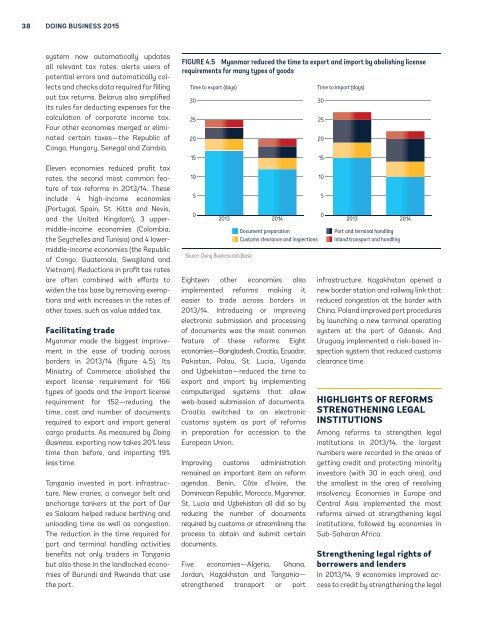bc8G2-7
bc8G2-7
bc8G2-7
You also want an ePaper? Increase the reach of your titles
YUMPU automatically turns print PDFs into web optimized ePapers that Google loves.
38<br />
DOING BUSINESS 2015<br />
system now automatically updates<br />
all relevant tax rates, alerts users of<br />
potential errors and automatically collects<br />
and checks data required for filling<br />
out tax returns. Belarus also simplified<br />
its rules for deducting expenses for the<br />
calculation of corporate income tax.<br />
Four other economies merged or eliminated<br />
certain taxes—the Republic of<br />
Congo, Hungary, Senegal and Zambia.<br />
Eleven economies reduced profit tax<br />
rates, the second most common feature<br />
of tax reforms in 2013/14. These<br />
include 4 high-income economies<br />
(Portugal, Spain, St. Kitts and Nevis,<br />
and the United Kingdom), 3 uppermiddle-income<br />
economies (Colombia,<br />
the Seychelles and Tunisia) and 4 lowermiddle-income<br />
economies (the Republic<br />
of Congo, Guatemala, Swaziland and<br />
Vietnam). Reductions in profit tax rates<br />
are often combined with efforts to<br />
widen the tax base by removing exemptions<br />
and with increases in the rates of<br />
other taxes, such as value added tax.<br />
Facilitating trade<br />
Myanmar made the biggest improvement<br />
in the ease of trading across<br />
borders in 2013/14 (figure 4.5). Its<br />
Ministry of Commerce abolished the<br />
export license requirement for 166<br />
types of goods and the import license<br />
requirement for 152—reducing the<br />
time, cost and number of documents<br />
required to export and import general<br />
cargo products. As measured by Doing<br />
Business, exporting now takes 20% less<br />
time than before, and importing 19%<br />
less time.<br />
Tanzania invested in port infrastructure.<br />
New cranes, a conveyor belt and<br />
anchorage tankers at the port of Dar<br />
es Salaam helped reduce berthing and<br />
unloading time as well as congestion.<br />
The reduction in the time required for<br />
port and terminal handling activities<br />
benefits not only traders in Tanzania<br />
but also those in the landlocked economies<br />
of Burundi and Rwanda that use<br />
the port.<br />
FIGURE 4.5 Myanmar reduced the time to export and import by abolishing license<br />
requirements for many types of goods<br />
Time to export (days)<br />
30<br />
25<br />
20<br />
15<br />
10<br />
5<br />
0<br />
2013<br />
Source: Doing Business database.<br />
2014<br />
Document preparation<br />
Customs clearance and inspections<br />
Eighteen other economies also<br />
implemented reforms making it<br />
easier to trade across borders in<br />
2013/14. Introducing or improving<br />
electronic submission and processing<br />
of documents was the most common<br />
feature of these reforms. Eight<br />
economies—Bangladesh, Croatia, Ecuador,<br />
Pakistan, Palau, St. Lucia, Uganda<br />
and Uzbekistan—reduced the time to<br />
export and import by implementing<br />
computerized systems that allow<br />
web-based submission of documents.<br />
Croatia switched to an electronic<br />
customs system as part of reforms<br />
in preparation for accession to the<br />
European Union.<br />
Improving customs administration<br />
remained an important item on reform<br />
agendas. Benin, Côte d’Ivoire, the<br />
Dominican Republic, Morocco, Myanmar,<br />
St. Lucia and Uzbekistan all did so by<br />
reducing the number of documents<br />
required by customs or streamlining the<br />
process to obtain and submit certain<br />
documents.<br />
Five economies—Algeria, Ghana,<br />
Jordan, Kazakhstan and Tanzania—<br />
strengthened transport or port<br />
Time to import (days)<br />
30<br />
25<br />
20<br />
15<br />
10<br />
5<br />
0<br />
2013<br />
Port and terminal handling<br />
Inland transport and handling<br />
2014<br />
infrastructure. Kazakhstan opened a<br />
new border station and railway link that<br />
reduced congestion at the border with<br />
China. Poland improved port procedures<br />
by launching a new terminal operating<br />
system at the port of Gdansk. And<br />
Uruguay implemented a risk-based inspection<br />
system that reduced customs<br />
clearance time.<br />
HIGHLIGHTS OF REFORMS<br />
STRENGTHENING LEGAL<br />
INSTITUTIONS<br />
Among reforms to strengthen legal<br />
institutions in 2013/14, the largest<br />
numbers were recorded in the areas of<br />
getting credit and protecting minority<br />
investors (with 30 in each area), and<br />
the smallest in the area of resolving<br />
insolvency. Economies in Europe and<br />
Central Asia implemented the most<br />
reforms aimed at strengthening legal<br />
institutions, followed by economies in<br />
Sub-Saharan Africa.<br />
Strengthening legal rights of<br />
borrowers and lenders<br />
In 2013/14, 9 economies improved access<br />
to credit by strengthening the legal


